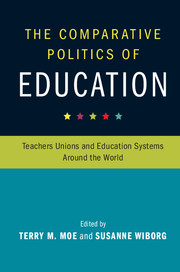Book contents
- Frontmatter
- Contents
- List of Contributors
- 1 Introduction
- 2 Teachers Unions in the United States: The Politics of Blocking
- 3 Teacher Unions in England: The End is Nigh?
- 4 Teacher Unionism in France: Making Fundamental Reform an Impossible Quest?
- 5 Teacher Unionism in Germany: Fragmented Competitors
- 6 Teachers Unions in the Nordic Countries: Solidarity and the Politics of Self- Interest
- 7 Teachers' Unions in Japan: The Frustration of Permanent Opposition
- 8 Teachers' Unions in Mexico: The Politics of Patronage
- 9 Teacher Unions in India: Diverse and Powerful
- 10 The Comparative Politics of Education: Teachers Unions and Education Systems Around the World
- Index
- References
6 - Teachers Unions in the Nordic Countries: Solidarity and the Politics of Self- Interest
Published online by Cambridge University Press: 22 December 2016
- Frontmatter
- Contents
- List of Contributors
- 1 Introduction
- 2 Teachers Unions in the United States: The Politics of Blocking
- 3 Teacher Unions in England: The End is Nigh?
- 4 Teacher Unionism in France: Making Fundamental Reform an Impossible Quest?
- 5 Teacher Unionism in Germany: Fragmented Competitors
- 6 Teachers Unions in the Nordic Countries: Solidarity and the Politics of Self- Interest
- 7 Teachers' Unions in Japan: The Frustration of Permanent Opposition
- 8 Teachers' Unions in Mexico: The Politics of Patronage
- 9 Teacher Unions in India: Diverse and Powerful
- 10 The Comparative Politics of Education: Teachers Unions and Education Systems Around the World
- Index
- References
Summary
Introduction
Teacher unions in the Scandinavian countries (Denmark, Norway and Sweden) were once exceptionally powerful, a situation facilitated by the corporatist political system and the social democrats – the largest political party. However, corporatist governance and social democracy have weakened over the last three decades, which has reduced teacher unions’ influence on national policy formulation and diminished their bargaining power. Nevertheless, teacher unions have proved resilient as they have found new allies and avenues, especially at local level, to exercise their power. The diminution of teacher union power across the Scandinavian states has varied considerably – the Swedish teacher unions have experienced greater reduction of power than their counterparts in Norway and Denmark. In striking contrast to Scandinavia, the single teacher union in Finland has remained immensely influential and therefore is a bit of an outlier.
Research on teacher unions in the Nordic countries is sparse, particularly in Finland, and tends to be conducted by researchers commissioned by teacher unions. There are no studies on how the teacher unions as political actors have exercised power through a corporatist tradition that makes the unions part of the political system and the civil administration. The close involvement of organised interests in public policy-making – which makes such interests an integral part of the political structure of the Nordic countries – is evidenced in numerous studies that place Scandinavia, but not Finland, at the upper end of scales measuring the degree of interest integration (Lijphart and Crepaz 1991; Rommetvedt 2003: 134). The corporate system affords teacher unions a number of opportunities to exercise influence over policy initiatives, legislative decision-making and policy implementation. In order to understand the extent to which teacher unions are enabled to influence policy, it is crucial to investigate this system of corporatism and how it has changed in recent years. Corporatism can be understood as an ‘institutional arrangement whereby important political-economic decisions are reached via negotiations between or in consultation with peak-level representation of employees and employers (or other interest groups and the state)’ (Kenworthy 2003: 11).
The first part of the chapter will analyse how and why corporatism and social democracy were propitious for the rise of teacher union power, and in which ways the unions’ interests played out in education politics and collective bargaining from the interwar period until the 1980s.
- Type
- Chapter
- Information
- The Comparative Politics of EducationTeachers Unions and Education Systems around the World, pp. 144 - 191Publisher: Cambridge University PressPrint publication year: 2016
References
- 6
- Cited by

